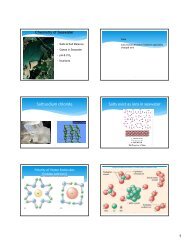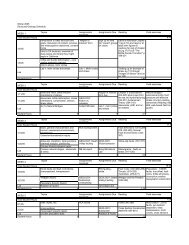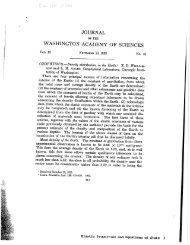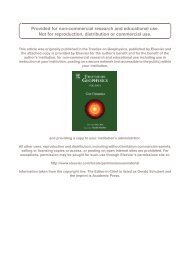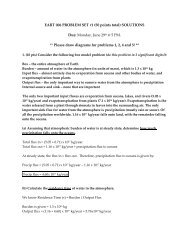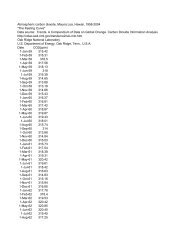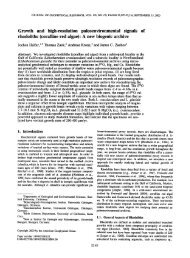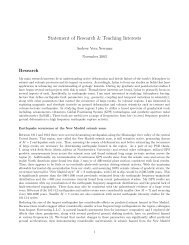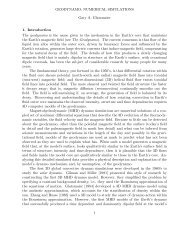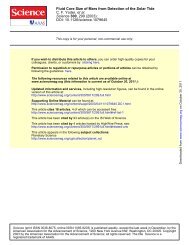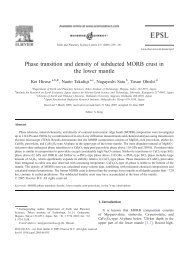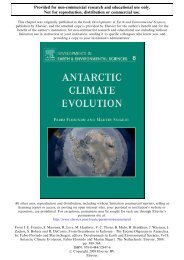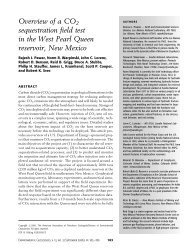Reprint - Earth & Planetary Sciences - University of California, Santa ...
Reprint - Earth & Planetary Sciences - University of California, Santa ...
Reprint - Earth & Planetary Sciences - University of California, Santa ...
You also want an ePaper? Increase the reach of your titles
YUMPU automatically turns print PDFs into web optimized ePapers that Google loves.
134 suggested endogenic activities. However, the nature <strong>of</strong> these activities was not well understood. For<br />
135 a more detailed discussion <strong>of</strong> our knowledge before Cassini, see Dougherty et al. (2009) and Orton<br />
136 et al. (2009). In terms <strong>of</strong> geology, the Cassini mission was designed to provide significantly better<br />
137 area coverage, spatial resolution, and spectral range, resulting in numerous new discoveries. A<br />
138 detailed description <strong>of</strong> the Cassini mission can be found in Dougherty et al. (2009) and Seal et al.<br />
139<br />
140<br />
(2009). Maps <strong>of</strong> the Saturnian satellites are included in Roatsch et al. (2009).<br />
141 21.2 Cassini’s Exploration <strong>of</strong> Saturn’s Icy Satellites<br />
142 The Cassini spacecraft is equipped with instruments tailored to investigate the surfaces,<br />
143 environments and interiors <strong>of</strong> icy satellites. The optical remote sensing (ORS) instrument suite<br />
144 includes cameras and spectrometers designed for high spatial and spectral resolution covering<br />
145 wavelengths between 0.06µm and 1000µm. With the imaging subsystem (ISS) (Porco et al., 2004),<br />
146 morphologic, stratigraphic and other geological surface properties can be observed at spatial<br />
147 resolutions down to a few meters (locally) or a few hundred meters (globally), depending on flyby<br />
148 distances. Moreover, as many as 33 color and polarization filter combinations permit mapping<br />
149 geologically diverse terrain spatially at wavelengths between ~0.3µm and ~1.1µm. The visible and<br />
150 infrared mapping spectrometer (VIMS; 0.4µm to 5.1µm) provides chemical and compositional<br />
151 spectral information with spatial resolutions from a few kilometers (globally) to better than one<br />
152 hundred meters (locally) (Brown et al., 2004; Jaumann et al., 2006). The composite infrared<br />
153 spectrometer (CIRS) determines global and regional surface temperatures and thermal properties on<br />
154<br />
155<br />
a kilometer scale (Flasar et al., 2004). The ultraviolet imaging spectrograph (UVIS) provides<br />
information about thin atmospheres and volcanic plume structures as well as about water ice and<br />
156 other minor constituents on the surface (Esposito et al., 2004), operating in the 60nm - 190nm<br />
157 wavelength range. A suite <strong>of</strong> magnetosphere and plasma science (MAPS) instruments characterizes<br />
158 the satellites’ environments by in-situ methods. Micron-sized dust grains and neutral molecules<br />
159 released from the surface by active or passive processes (volcanoes/sputtering) carry surface<br />
160 composition information to distances as far as hundreds <strong>of</strong> kilometers above the surface. Released<br />
161 material affects the plasma surrounding the satellite and is registered by variations in the magnetic<br />
162 field, ion density, and neutral gas and dust density as well as gas and dusty composition.<br />
163 The primary task <strong>of</strong> the radio science subsystem (RSS) is to determine the mass <strong>of</strong> the moons (Tab.<br />
164 1) by tracking deviations in Cassini's trajectory. RADAR data can provide unique information about<br />
165 the upper sub-surface (Elachi et al., 2004), though few close-up RADAR SAR observations were<br />
166 performed during satellite flybys. The lack <strong>of</strong> a scan platform for the remote sensing instruments<br />
167 prevents the radio science, RADAR and remote sensing systems from operating simultaneously<br />
168 during a flyby because the antenna and remote sensing instruments are oriented 90° apart on the<br />
169 spacecraft. Even joint surface scans by the ORS instruments require significant compromises<br />
170 between individual observations due to data rate and integration time constraints. While the ISS<br />
171 instrument needs short 'dwell' times for mosaicking, the VIMS depend on long 'dwells' for<br />
172 improved signal-to-noise ratios. On the other hand, the CIRS and UVIS instruments contain line-<br />
173 scanning devices, which depend on either slow or fast slews to scan the surfaces. Thus, reaching<br />
174 satisfactory compromises is a major challenge in the planning process.<br />
175 Since the Cassini spacecraft orbits the planet rather than individual satellites, the moons can only be<br />
176<br />
177<br />
observed at various distances and illumination conditions, ideally during very close-targeted flybys.<br />
Depending on the distance <strong>of</strong> a moon to Saturn, the flybys occur at very different velocities. In<br />
178 March 2008, for instance, Enceladus was passed at ~14 km/s, while the Iapetus flyby in September<br />
179 2007 took place at a leisurely 2.4 km/s. The flyby geometry can also vary significantly. The closest-<br />
180 ever approach was during the Enceladus flyby on October 9, 2008, when the spacecraft skimmed as<br />
181 low as 25 km over Enceladus’ surface. Other, more typical targeted flyby altitudes occur between<br />
182 100 km and 2000 km. A flyby can be polar, equatorial, or in between, and at the closest approach,<br />
183 the sub-spacecraft point over a moon can be located either over its illuminated or over its unlit side.<br />
184 The MAPS instruments measure densities or field gradients over time. Sputtering processes lead to<br />
185 high dust and neutral-gas densities above the surface, so that environmental in-situ instruments rely<br />
186 on measurements as close to the surface as possible. Further plasma density variations caused by<br />
187 satellites moving in the magnetosphere are empty flux tubes (wakes) and the drop <strong>of</strong> plasma along<br />
188 the related L-shell. Crossing those regions is <strong>of</strong> high value for in-situ plasma investigations that<br />
189 provide indirect information about the satellite surface and the density <strong>of</strong> its neutral and plasma<br />
190 environment.<br />
191 During the nominal mission, Cassini performed nine targeted as well as numerous close flybys <strong>of</strong><br />
192<br />
icy satellites (Tab. 2).<br />
4



